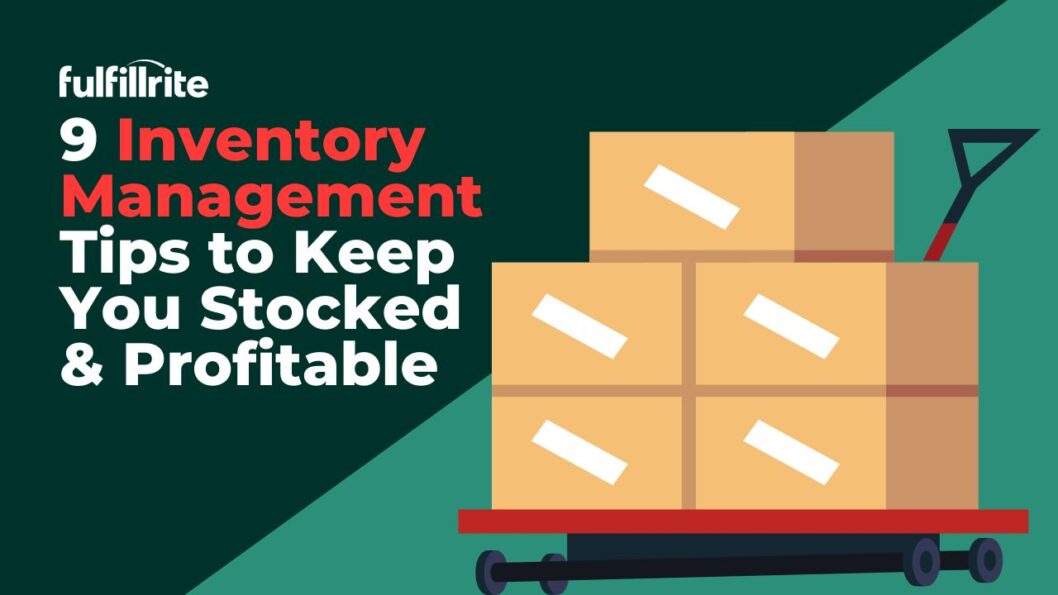If you followed the news in the post-pandemic season, you probably noticed that a lot of goods were in short supply. Everything from semiconductors to sausage, rental cars to lumber had been hard to come by. You could blame the pandemic for many of these shortages, sure, but the underlying issues were more complex. And one of those issues? Inventory management practices.
The 2010s were defined by lean supply chains. Everything was shipped just-in-time with little buffer for disruptions. This was really good for efficiency and profits, but really bad for handling unexpected events.
So with that in mind, we’re going to talk about what inventory management is and how you can do it well. By following these tips, you can reduce your risk of running out of stock when you need it. That means more money in your pocket, more happy customers, and a generally less stressful life as a business owner.
What is inventory management and why does it matter?
When you boil it down to the basics, inventory management is the process of tracking where products are, where they’re going, and when to order more. That’s really it!
Simple as the concept may seem, though, the practice is hard. You have to monitor a lot of moving parts while simultaneously predicting the future a la demand estimation. It looks easy until you have to do it.
But it’s worth building your skill set, because mastering inventory management best practices has many benefits for your business. We can think of four right here:
- You’ll be less likely to run out of stock. That means your customers can keep shopping anytime they please.
- You’ll be less likely to have too much stock. Holding onto excess inventory costs money in storage, not to mention the sunk cost of ordering too much in the first place. Good inventory management will keep you from over-ordering in the first place.
- You’ll have higher profits. Good inventory management helps you know what to sell, which increases revenue, while also helping you keep costs in check.
- You’ll benefit from better cash flow. If you get a sense of how much to spend and when to spend it, you won’t find yourself overcommitting large sums of money to buying more products when the timing is not good.
In short, inventory management helps you find a balance between two extremes. You don’t want to run out of items and you don’t want to hoard them, and this is the process by which you find the happy medium.

What are common inventory challenges that sellers run into?
To answer this question, I reached out to John Heberling, Senior Partnerships Manager at Kickfurther, an inventory financing firm. In response, he first mentioned the risk of ordering too much at once, stating that “direct-to-consumer (DTC) brands often struggle to balance stock when entering retail. A big purchase order sounds exciting, but without the capital to produce inventory for both retail and DTC channels, businesses risk losing revenue and growth opportunities.”
Heberling followed up by saying that “ordering too much of the wrong SKU leads to dead stock, tying up cash and adding storage costs.” To state another way, you simply don’t want to buy items – or variants of items – that won’t sell.
Other common and devastating issues mentioned by Heberling include “waiting too long to place an inventory order. [This] can destroy your bottom line—forcing you to pay for costly air freight or, even worse, leading to stockouts that cause missed sales.” He stresses that it’s particularly important to place timely orders in advance of busy seasons like the holidays.
There’s another new pressure too: unpredictable tariff costs. Chris Grippo, owner at The Shop Tinkerers, adds: “Costs are up across the board, especially for anything coming out of China. It’s forcing our clients to reevaluate sourcing, pricing, and margin strategy faster than we’d like.”
Paul Ferrara, Senior Wealth Counselor at Avenue Investment, points out another common issue. “Intuitive inventory systems tend to oscillate between excess inventory and stock outages.”
He advises using instead “a 90 day rolling average of sales, with the safety stock as [20% of monthly sales].” He says this will “provide a smoother reorder point that allows margins to be preserved and minimizes losses in clearance.”
Between the negative impacts of bad inventory processes, the ease of making common mistakes, and difficulty making inventory intuitive, it’s clear that smart inventory management has never been more critical to success.
8 main types of inventory
The whole idea of inventory management is to keep track of where products and other materials are so that you have visibility into the day-to-day operations of your business. Yet not all inventory is the same, and in order to have meaningful conversations about it, you must categorize inventory into different types.
- Raw materials. These are the materials that you use to create your products. Even if you are not the manufacturer of your products, it’s important to pay attention to the availability of raw materials.
- Unfinished products. These are the products that you or your manufacturer are currently working on making, but that are not ready to sell.
- Finished products. These are products that are ready to sell right now. They are often stored in a warehouse or fulfillment center such as our own.
- In-transit goods. These are goods that are being transported somewhere else, such as finished goods en route to the warehouse or to the customer.
- Cycle inventory. This is inventory which is bought from a manufacturer or other supplier and shipped directly to your customer. (This is the only kind of inventory present in dropshipping businesses.)
- Buffer inventory. Also known as safety stock, this is the inventory that you keep around in case something bad happens that prevents you from getting the inventory you need.
- Packing inventory. This is the inventory you keep for your packing supplies, such as finished packaging or even bubble wrap and mailers.
- MRO inventory. This is inventory needed for maintenance, repair, and operations. This supports the production process, and is not what goes out to your customers.

9 tips for inventory management
1. Find good inventory management software
You can manage inventory by hand or in a spreadsheet, and that’s fine for a little while. It doesn’t scale well, though.
If you want to keep track of inventory while minimizing upkeep, look into inventory management software. Some good options include Orderhive, Zoho, and even Quickbooks.
2. Categorize your inventory by priority
Not all inventory is the same. It helps to categorize your inventory so that you can understand which inventory is moving and which inventory is making you money.
Experts typically suggest segregating your inventory into A, B and C groups. Items in the A group are higher-ticket items that you need fewer of. Items in the C category are lower-cost items that turn over quickly. The B group is what’s in between: items that are moderately priced and move out the door more slowly than C items but more quickly than A items. – 10 Essential Tips for Effective Inventory Management, Business News Daily
By prioritizing inventory using an A, B, C system, you’ll come to find that most of your profits will come from a relatively small amount of your stock. This is the Pareto principle (or 80/20 rule) at work. If you need to narrow down your focus in order to effectively manage your inventory, consider focusing on just the 20% of your inventory that brings the most money.
3. Keep track of all relevant data
Inventory management requires keeping track of a lot of different types of data. That includes SKUs, bar codes, countries of origin, product values, lot numbers, HS codes, and a lot more. Using your inventory software of choice, make sure that you are rigorous about tracking all the relevant data for each kind of item you carry.
It may also be a good idea to track information like the cost of the item, its seasonal sales patterns, and whether or not there are hard-to-come-by supplies that go into its manufacturing. Having data organized like this will help you find answers to unpredictable questions that may arise as your day-to-day business operations take place.
4. Monitor sales
Ultimately, every company wants and needs to make money. The best way to keep doing this is to observe which items are bringing in the most revenue.
But what do you look for when you monitor sales? A few things come to mind:
- How much is each type of item making?
- Are there seasonal patterns to sales?
- Do the sales for one item increase the sales for other items?
- Do you tend to sell more on specific days of the week or times of the day?
5. Get a feel for sales cycles
After enough sales monitoring, you will start to see how sales cycles work. You can then use this information to sell to customers when they are most likely to be buying. You can also use this information to make sure you have new stock ready to go for whenever the next round of sales is going to come in.
6. Be proactive about quality control
Customers expect your products to be good ones. If someone’s first experience with your brand involves a dud product, then they probably aren’t going to come back. If a regular customer has a bad experience, they might be a little too lenient, but only if it doesn’t happen again.
For every new batch of inventory you receive, it’s worth your time to test the merchandise. This is doubly true if something has changed recently that may affect the quality of the product. Better safe than sorry!
7. Make sure you have a good returns process
Returns are a part of life in retail. This is especially true in eCommerce where return rates can be 30% or higher. You need to make sure you have a good returns process.
Part of that returns process will involve figuring out what to do with the inventory when it is received once more. Some returns can be put back into inventory and resold, others need to be thrown away, and still others may need repair or refurbishment. No matter what the case is, make sure you have well-defined processes for inventory management when the returns inevitably come in.
8. Order your own restocks (at least at first)
Once you have a feel for your inventory cycles, you will also have a feel for when to restock. At first, order restocks on your own. Even the best software or account managers cannot always see all the variables that are necessary to know when to order more inventory. Once you determine the pattern in your decision to restock, then it’s time to delegate to someone else!
9. Conduct regular audits
No matter how good you are at tracking inventory, you will occasionally make mistakes. Sometimes, an item isn’t scanned on the way out. Other times, it’s stolen from your store or your warehouse. These things happen.
Every once in a while, be it annually or weekly, it’s worthwhile to audit your inventory and find out how much you truly have. Nothing is quite as uncomfortable as thinking you have 100 items in stock when you actually have none!
Final Thoughts
Good inventory management can keep your customers happy and your profits healthy. The basic idea is simple, to be sure, but when you apply these simple principles around forecasting, flexibility, and quality control, you can gain a major competitive advantage.
And in a world where tariff hikes and supply chain disruptions are more common, keeping tight control over your inventory isn’t just smart. It’s required.

